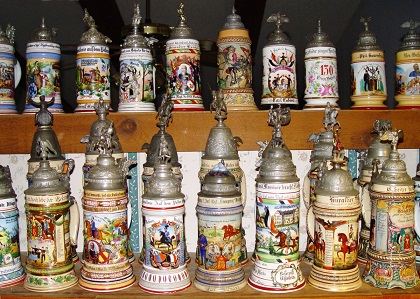 The origins of beer steins date back to the 14th century. As a result of the bubonic plague and several invasions of flies throughout Europe, Germany established several laws in the early 16th century requiring that all food and beverage containers be covered to protect their contents. By combining a lid, hinge, and thumblift, these ‘German’ containers could easily be opened and closed with one hand. About this time many efforts were also made to improve the earthenware material used for steins. By raising the firing temperature, clay was vitrified into a solid, moisture-free, stone-like material called stoneware. Because this new material was much more durable than the previous earthenware, steins made of stoneware became very popular and many different types of designs and decorations were artistically applied to them.
The origins of beer steins date back to the 14th century. As a result of the bubonic plague and several invasions of flies throughout Europe, Germany established several laws in the early 16th century requiring that all food and beverage containers be covered to protect their contents. By combining a lid, hinge, and thumblift, these ‘German’ containers could easily be opened and closed with one hand. About this time many efforts were also made to improve the earthenware material used for steins. By raising the firing temperature, clay was vitrified into a solid, moisture-free, stone-like material called stoneware. Because this new material was much more durable than the previous earthenware, steins made of stoneware became very popular and many different types of designs and decorations were artistically applied to them.
The word “stein” is of German origin. The etymology of the word is either from “Stein Krug” (meaning stone jug/mug) or from “Steingut” (meaning stone goods). Steins are mugs used for drinking beer. They have a handle and a hinged lid; are decorated and sometimes hand-painted.
Steins may be traditional, regimental, occupational (depicting one’s occupation), character (figural), or relief (three-dimensional). They may be new, antiques, reproductions, or limited editions.
Steins range in volume from .03 liter (1 oz.) to 32 liter (8.4 gal.), the typical volume being .5 (1/2) liter (16.9 oz.).
Steins often have a theme such as Christmas, wildlife, dogs, military, sports, game fish, etc. Europeans often engraved dates on the lids of steins to commemorate specific occasions, such as birthdays, anniversaries, sporting events, weddings, and retirements.
Stein materials
The history of steins includes the development and introduction of several different materials other than stoneware. Pewter was not only used for lids, but also as a primary body material. It was the material of choice throughout large areas of Europe and particularly popular in England. Glass, porcelain and silver steins were introduced several hundred years ago as well and are all still available today. Today, the stein and tankard industry remains primarily represented by those factories in Germany and England who are from the original regions where history has demonstrated the industry to have been founded. Centuries-old traditions continue to train the skilled hands and eyes that are required to create these steins.
STONEWARE (German-Steinzeug) – Hard material, fired in high temperature kilns generally around 1,200 °C to 1,400 °C . At this temperature, stoneware vitrifies (becomes glass-like).
PEWTER – A pliable compound consisting of tin, copper, and antimony. European pewter has a minimum tin content of 94%. Copper and antimony are added to harden the metal. The higher the tin content, the more silver the final color.
CRYSTAL – denotes a material consisting of 24% or more lead crystal. The body is hand-cut, hand engraved and/or patterned by the mold. They are case hardened, usually are mouth-blown and often feature transparent coloring on exterior and/or the interior of the body.
GLASS – The least expensive of all popular materials. Unlike the procedure for making stoneware, pewter, and crystal steins, glass bodies and handles are formed in one mold. Also, the lids are often attached by machine.
CERAMIC MATERIALS – Ceramic steins fall into one of five categories according to the quality of the ceramic mass, the raw materials, the firing temperature, the color, and density of the mass.
PORCELAIN (German-Porzellan) – True porcelain, known as hard paste, is made of Kaolin (white clay) and Pentuntse (pulverized granite). When fired at a temperature of 1,300 °C to 1,400 °C , these ingredients produce a white, more or less translucent, glass-like material.
Current producers
Some of the current producers of beer steins are: Liegl, Kaiser Porcelain,B.M.F, Zimmerman, Rastal, A.J. Thewalt, Simon Peter Getz, Albert Stahl & Co., Lindner Porzellan, King Werks, Bockling Glas, Merkelbach, Tradex, W. Corzelius, Villeroy & Boch, Domex, M. Girmscheid, Kurt Hammer.
Related articles:
The History of German Beer Steins
How to Taste Beer
German Beer – the Absolutely German Drink







